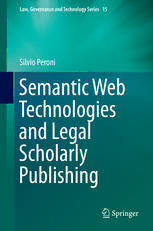
Semantic Web Technologies and Legal Scholarly Publishing PDF
Preview Semantic Web Technologies and Legal Scholarly Publishing
Semantic Web Technologies and Legal Scholarly Publishing Law, Governance and Technology Series VOLUME15 SeriesEditors: POMPEUCASANOVAS,InstituteofLawandTechnology,UAB,Spain GIOVANNISARTOR,UniversityofBologna(FacultyofLaw–CIRSFID) andEuropean,UniversityInstituteofFlorence,Italy ScientificAdvisoryBoard: GIANMARIAAJANI, University of Turin, Italy; KEVINASHLEY, University of Pittsburgh, USA; KATIEATKINSON,UniversityofLiverpool,UK;TREVORJ.M.BENCH-CAPON,UniversityofLiv- erpool,UK;V.RICHARDSBENJAMINS,Telefonica,Spain;GUIDOBOELLA,Universita’degliStudi diTorino,Italy;JOOSTBREUKER,UniversiteitvanAmsterdam,TheNetherlands;DANIÈLEBOUR- CIER,UniversityofParis2-CERSA,France;TOMBRUCE,CornellUniversity,USA;NURIACASEL- LAS, Institute of Law and Technology, UAB, Spain; CRISTIANO CASTELFRANCHI, ISTC-CNR, Italy; JACK G. CONRAD, Thomson Reuters, USA; ROSARIA CONTE, ISTC-CNR, Italy; FRAN- CESCOCONTINI,IRSIG-CNR,Italy;JESÚSCONTRERAS,iSOCO,Spain;JOHNDAVIES,British Telecommunicationsplc,UK;JOHNDOMINGUE,TheOpenUniversity,UK;JAIMEDELGADO,Uni- versitatPolitécnicadeCatalunya,Spain;MARCOFABRI,IRSIG-CNR,Italy;DIETERFENSEL,Uni- versityofInnsbruck,Austria;ENRICOFRANCESCONI,ITTIG-CNR,Italy;FERNANDOGALINDO, UniversidaddeZaragoza, Spain;ALDOGANGEMI,ISTC-CNR,Italy; MICHAELGENESERETH, StanfordUniversity, USA;ASUNCIÓNGÓMEZ-PÉREZ,UniversidadPolitécnicadeMadrid, Spain; THOMASF.GORDON,FraunhoferFOKUS,Germany;GUIDOGOVERNATORI,NICTA,Australia; GRAHAMGREENLEAF,TheUniversityofNewSouthWales,Australia;MARKOGROBELNIK,Josef StefanInstitute,Slovenia;SERGEGUTWIRTH,VrijeUniversiteitBrussels;JAMESHENDLER,Rens- selaerPolytechnicInstitute,USA;RINKEHOEKSTRA,UniversiteitvanAmsterdam,TheNetherlands; ETHANKATSH,UniversityofMassachusettsAmherst,USA;MARCLAURITSEN,CapstonePractice Systems, Inc., USA; RONALD LEENES,Tilburg Institute for Law, Technology, and Society, Tilburg University, TheNetherlands; PHILIPLIETH,Queen’sUniversityBelfast, UK;ARNOLODDER,VU UniversityAmsterdam,TheNetherlands;JOSÉMANUELLÓPEZCOBO,Playence,Austria;PIERRE MAZZEGA, LMTG-UMR5563 CNRS/IRD/UPS, France; MARIE-FRANCINE MOENS, Katholieke UniversiteitLeuven,Belgium;PABLONORIEGA,IIIA-CSIC,Spain;ANJAOSKAMP,OpenUniver- siteit,TheNetherlands;SASCHAOSSOWSKI,UniversidadReyJuanCarlos,Spain;UGOPAGALLO, UniversitàdegliStudidiTorino,Italy;MONICAPALMIRANI,UniversitàdiBologna,Italy;ABDUL PALIWALA,UniversityofWarwick,UK;ENRICPLAZA,IIIA-CSIC,Spain;MARTAPOBLET,RMIT University, Melbourne, Australia; DANIEL POULIN, Lexum informatique juridique Inc., Canada; HENRYPRAKKEN,UniversiteitUtrechtandTheUniversityofGroningen,TheNetherlands;HAIBIN QI,HuazhongUniversityofScienceandTechnology,P.R.China;DORYREILING,AmsterdamDistrict Court, TheNetherlands; PIERCARLOROSSI,Italy; EDWINAL.RISSLAND,UniversityofMas- sachusetts,Amherst,USA;COLINRULE,UniversityofMassachusetts,USA;MARCOSCHORLEM- MER,IIIA-CSIC,Spain;CARLESSIERRA,IIIA-CSIC,Spain;MIGELANGELSICILIA,Universidad deAlcalá,Spain;RONALDW.STAUDT,Chicago-KentCollegeofLaw,USA;RUDISTUDER,Karl- sruhe Institute of Technology, Germany; DANIELA TISCORNIA, ITTIG-CNR, Italy; JOAN-JOSEP VALLBÈ,UniversitatdeBarcelon,Spain;TOMVANENGERS,UniversiteitvanAmsterdam,TheNeth- erlands;FABIOVITALI,UniversitàdiBologna,Italy;MARY-ANNEWILLIAMS,TheUniversityof Technology, Sydney, Australia; RADBOUDWINKELS, University of Amsterdam, The Netherlands; ADAMWYNER,UniversityofLiverpool,UK;HAJIMEYOSHINO,MeijiGakuinUniversity,Japan; JOHNZELEZNIKOW,UniversityofVictoria,Australia Forfurthervolumes: http://www.springer.com/series/8808 Silvio Peroni Semantic Web Technologies and Legal Scholarly Publishing 2123 SilvioPeroni DepartmentofComputerScienceandEngineering UniversityofBologna MuraAnteoZamboni7 40126Bologna(BO) Italy ISSN2352-1902 ISSN2352-1910(electronic) ISBN978-3-319-04776-8 ISBN978-3-319-04777-5(eBook) DOI10.1007/978-3-319-04777-5 SpringerChamHeidelbergNewYorkDordrechtLondon LibraryofCongressControlNumber:2014934451 © SpringerInternationalPublishingSwitzerland2014 Thisworkissubjecttocopyright.AllrightsarereservedbythePublisher,whetherthewholeorpartofthe materialisconcerned,specificallytherightsoftranslation,reprinting,reuseofillustrations,recitation, broadcasting,reproductiononmicrofilmsorinanyotherphysicalway,andtransmissionorinformation storageandretrieval,electronicadaptation,computersoftware,orbysimilarordissimilarmethodology nowknownorhereafterdeveloped.Exemptedfromthislegalreservationarebriefexcerptsinconnection withreviewsorscholarlyanalysisormaterialsuppliedspecificallyforthepurposeofbeingenteredand executed on a computer system, for exclusive use by the purchaser of the work. Duplication of this publicationorpartsthereofispermittedonlyundertheprovisionsoftheCopyrightLawofthePublisher’s location,initscurrentversion,andpermissionforusemustalwaysbeobtainedfromSpringer.Permissions forusemaybeobtainedthroughRightsLinkattheCopyrightClearanceCenter.Violationsareliableto prosecutionundertherespectiveCopyrightLaw. Theuseofgeneraldescriptivenames,registerednames,trademarks,servicemarks,etc.inthispublication doesnotimply,evenintheabsenceofaspecificstatement,thatsuchnamesareexemptfromtherelevant protectivelawsandregulationsandthereforefreeforgeneraluse. Whiletheadviceandinformationinthisbookarebelievedtobetrueandaccurateatthedateofpublication, neithertheauthorsnortheeditorsnorthepublishercanacceptanylegalresponsibilityforanyerrorsor omissionsthatmaybemade.Thepublishermakesnowarranty,expressorimplied,withrespecttothe materialcontainedherein. Printedonacid-freepaper SpringerispartofSpringerScience+BusinessMedia(www.springer.com) Foreword What you are holding in your hand is a multi-faceted book. From where I stand, thereareatleastthreedifferentpointsofviewthatcanbetakentoreaditandenjoy itsideasandconceptualframework. Firstofall,thisisabookproposinginnovativeideasaboutLegalPublishing.As such,positioningitwithintheLaw,GovernanceandTechnologySeriesofSpringer Verlag is proper and true to its nature and aims: Peroni’s work contributes new conceptsandsolutionsformanaginglegaltexts(doctrineaswellaslegislationand jurisprudence),placingthemasthecoreculturalinfrastructureuponwhichtheuni- verse of legal activities is based, whose workflow (from ideation to drafting, to evaluation, to publication, to evolution, to oblivion or removal) is instrumental to thecorrectunderstandingoflegalprocesses,andwhosesemanticrepresentationisa compellingandexemplaryapplicationofSemanticWebtechnologiesthatprovides solid bases for innovative tools helping professionals and laymen in cataloguing, searching,andreasoninguponlegalknowledge. Andyet,asecondmainviewpointemerges,thatofSemanticPublishing,consti- tutinganexplicit, confessed, andtransparentfocusdrift, wherebylegalpublishing isheldasbutoneinstanceofmanyinthelargerclassofpublishingcontexts,where similarities are more important than differences, so that they can be studied and describedasonediscipline. In this sense, document publishing can be seen as the main theme of the book, andthelegaldomainasjustthefrontmostexample.Severaltopicsofgreattimeliness andcomplexityaretackledandrelevantcontributionsareprovidedunderoneencom- passingparadigmgivingthemintegrityanduniformity:fromtheissueofmanaging multiple, reciprocally inconsistent structures over the same content (a well-known probleminthemarkupcommunitysincetheearlydaysofTEI)totheproblemofthe accuratedescriptionofthedomainofscholarlypublishing,totheissueofproviding informativeandeasilyunderstandablepresentationofmetadatarecordsofpublica- tions to a lay audience, we are shown a full catalogue of tough problems whose solutionsinliteratureare,atpresent,hardlysatisfactory.YetPeroninotonlytackles them providing more advanced proposals and ideas than in literature, but does so byintroducingtoitsfullpowerjustonenewapproach,thatofSemanticWebtech- nologies,showinghowpowerfulandeleganttheyareinaddressingcomplexissues. v vi Foreword Namely, multiple hierarchies are in fact managed through overlapping markup as suggested long ago in literature, but through the use of Semantic Web ontologies Peronigiveslifetoafullynewmeta-markuplanguage, EARMARK,thatsuccess- fullyandautomaticallyreplacesXMLwithoutloosingthegeneralityandavailability ofitstools.Similarly,metadataforscholarlypublishingareinfactmanagedthrough ontologies, as suggested in innumerable publications of the last twenty years, but Peronisuggestsaunifyingframeworkofeightdifferentontologies,SPAR,integrat- inginthesameconceptualizationissuesasdifferentastheFRBR-baseddescription oftherelationshipsbetweenversionsofthesamework,thefinestdistinctionofroles and stages in scholarly publishing, the rhetorical roles of sections and fragments in scholarly articles.Also and consequently, the familiarity of Peroni to Semantic Web technologies allows him to produce end-user tools that are immediately and concretelyusefultothelaymanandprofessionalalike:hisdocumentationtool,his keyconceptextractorandhisvisualizationtoolforOWLontologiesareimmediately useful in the publishing domain and therefore in the legal publishing domain, but theyare,atheart,extremelygeneraltoolsthatareusefulwhereverOWLontologies areemployed. Butthereisathirdpointofviewinthisbook,abackgroundthemeconnectingall foregroundtopics.Wecouldcallitthetime-andcontext-awaredesignpattern, an approachtodescribingandformalizingcomplexdomainsbytakingintoaccountthe unavoidableevolutionsintimeorcontextthatsoonerorlaterwillaffectthedesign. Forinstance,traditionalontologiesforpublishingoftenconsidereditionsasfirst- class concepts, fixed in time and absolute in their nature, and therefore downplay the existence of connections between subsequent versions or variants of the same publication;ontologiesoforganizationaldomainoverloadthedescriptionoftheac- tors involved with the roles they hold, as if role was a persistent characteristic of anindividualoranorganization:isbeingamemberoftheparliamentapermanent or transient characteristic of a politician? Is being a draft discussed by a specific commission a permanent or transient characteristic of a bill? Handling time and context-aware characterization of complex domains is not straightforward, and al- thoughliteratureofbestpracticesforontologydesignhasfrequentlydiscussedthe drawbacksofignoringtimeinformalizations,andhasproposedanumberofdesign approaches that take care of time and contexts, the world is full of important and widespreadontologiesthatdescribesketchesofrealityfrozenintime,possiblynot wrongnow,butsurelytobecomewrongsometimeinthefuture.Peroni’sapproachis systematically,sometimespainfullyawareofthefactthattimeandcontextschange andaffectformalizations,andmakessurethatthemarkuplanguages,theontologies, thetoolsheproposescanhandleinasophisticatedmannerdomainsthatevolvein timeandthathavedifferentcharacteristicsdependingoncontexts.Fromthispointof view,IbelievethatSection5.5ofthisbook,providingtheontologicaldesignpattern for handling time and context aware formalizations of domains, is the conceptual pivotofthewholebook,andprovidesthefundamentalsofanextremelymatureand self-consciousscholarlyapproachbyPeroni. Foreword vii Inthelastfiveyears,IwitnessedSilvioPeroni’sculturalevolutionfromtheearly projectsasaneagermasterstudenttothefullscientificmaturityofthisbook,arich rewriting and extension of his PhD thesis. It is with pleasure and fondness that I seemanylongandthought-provokingdiscussionswithhimendupinthisbookas fully-expressedandconvincingargumentations,dutifullybackedupinliteratureand tightlyconnectedwithpracticalapplicationsandactualtools.Ifeelhonouredtohave beeninvolvedinhisworkandtohavebeencollaboratingwithSilviointheseyears. DepartmentofComputerScienceandEngineering Prof.FabioVitali UniversityofBologna Preface This book introduces theories, formalisms and applications that permit effective interactionbetweenlegalscholarlydocumentsandtheirrelatedsemanticandformal descriptions,usingthesemantictechnologiesthathavebeenemployedtocreatethe SemanticWebandLinkedData.SuchanapplicationofSemanticWebtechnologies totheworldofdocumentsandpublishingisheretermedSemanticPublishing. ResearchandpublishinginLawhavealongtraditionofapplyingsuchsemantic technologies to real-world scenarios. In this context, the aim of this book is to describeandproposesolutionstothreeofthemainissuesfacedbytheapplication ofSemanticPublishingwithinthecontextofthelegalscholarlydocuments,namely: theneedfortoolstolinkdocumenttexttoaformalrepresentationofitsmeaning;the requirementforcompletemetadataschemas/ontologiesthatcanbeusedtodescribe documents using the language and vocabulary of the world of publishing; and the demandforeffectiveuserinterfacesthatpermitsuchtoolsandschemastobeapplied inpractice. Thefirstsectionofthisbookdescribesmarkuptheoryandtechnology,wherebya bettercomprehensionofadocumentcanbederivedfromadescriptionofitsstructural organisationandoftheformalsemanticscontainedwithinit,andfromclarificationof howthesetwotypesofmarkup—structuralandsemantic—canoverlapandinteract. In digital documents, the way we say something about a text is by the addition of markup,bywhichismeantadditionalstatements,notnormallyrenderedvisiblefor human reading, that define and delimit structural or semantic features of the text. Markuphasbeenusedforyearsforannotatingdocumentsatalllevelsofgranularity, from the digital document as a whole to its sub-components. However, the most commonlyuseddocumentformatsemployedinpublishing(i.e.,XMLandPDF)were notdevelopedprimarilytoenablesemanticenhancementandoverlappingmarkup, althoughinprincipleitispossibletousethemforthispurpose.Tofacilitatethetaskof integratingpotentiallyoverlappingstructuralandsemanticmarkup,Ihavedeveloped anOWL-basedmarkupmetalanguagecalledEARMARK.EARMARKeddocuments are collections of addressable text fragments associated with OWL assertions that describethestructuralandsemanticpropertiesof(partsof)thatcontent. ix x Preface DigitaldocumentsandtheircontentformthefocusofSemanticPublishing,which enables their automated discovery and connection to other document-related re- sources and contexts, such as other articles and raw data. Unfortunately, existing Semantic Web vocabularies are too abstract and incomplete to cover the require- ments of the publishing world. There is thus an acute need for new vocabularies (ontologies) that comprehensively describe the different aspects of the publishing domain.Inthecentralsectionofthisbook,Idescribeasuiteoforthogonalandcom- plementaryOWL2DLontologymodules,theSemanticPublishingandReferencing (SPAR)Ontologies,thatenableallaspectsofthepublishingprocesstobedescribed in machine-readable metadata statements encoded using the Resource Description Framework(RDF). Thefinalsectionofthisbookdescribesnewtoolsandinterfacesthatenableusers touseandinteractwithsuchsemantictechnologiesandtocreatesemanticdata.This provision of new tools and interfaces is particularly crucial for Semantic Publish- ing,sinceitsend-usersaregenerallypublishers,researchers,readers,librarians,law scholars and the like, rather than computer scientists who are experts in semantic technologies.TheuseofsemanticlanguagesandvocabulariessuchasEARMARK and the SPAR Ontologies requires simple and easy-to-use human-computer inter- faces that facilitate their application to Semantic Publishing by non-experts. Here Iintroducefournewtoolsdevelopedtosupportusers: two(LODEandKC-Viz)to aidinunderstandinganontology;athird(Graffoo)thatassistsinpresentingsuchan ontology, or fragments of it, in comprehensible formalised diagrams; and a fourth (Gaffe)thatisusefulwhenemployingsuchanontologytocreatesemanticdefinitions ofrealdata.
